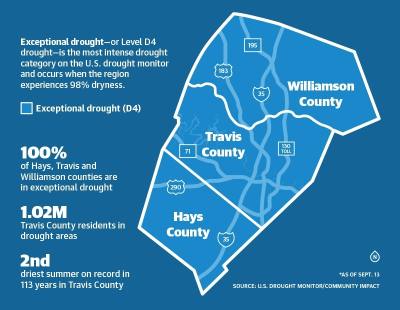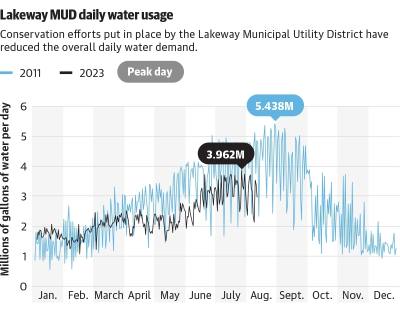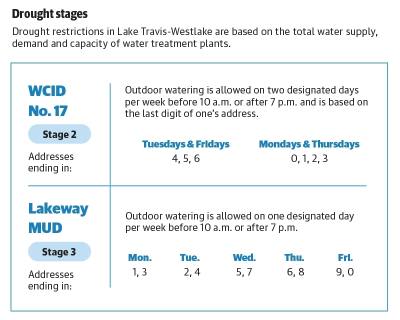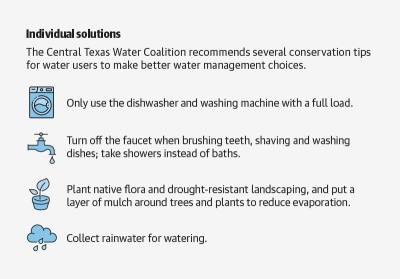Most of the Lake Travis area remains under Stage 2 restrictions, including the Travis County Water Control and Improvement District No. 17, which allows for outdoor irrigation a maximum of two days per week. The Lakeway Municipal Utility District, however, took a more aggressive conservation approach by entering Stage 3 water restrictions Aug. 15, allowing outdoor irrigation only one day per week.
Two-minute impact
Central Texas was hit with a double threat this summer: record-breaking high heat and little rainfall. The region has seen temperatures over 100 degrees nearly every day since July 8, causing increased evaporation of local water reservoirs, dried-out soil and increased wildfire risk.
Lakes Travis and Buchanan collectively dipped to 43% capacity Sept. 8, the lowest they’ve been since 2013, according to the Lower Colorado River Authority. Other regional water sources, including the Edwards Aquifer, Lake Georgetown and Stillhouse Hollow Lake, are similarly low.
“Given how long our [rainfall] deficits go back and how significant they are, we’ll continue to see drought impacts through the end of this year, almost guaranteed,” National Weather Service meteorologist Keith White said. “The good news about the El Niño, though, is that it will tilt our odds toward wetter conditions by the time we get into the winter time. So we can hopefully start to make up some of those deficits in December, January and February of next winter.”
Diving in deeper
Stephanie Threinen, Lakeway MUD public information liaison, said although the water district did not initiate Stage 3 water restrictions until Aug. 15, the board approved moving to once-weekly irrigation restrictions Sept. 1, 2022.
About 50% of LMUD accounts used fewer than 300 gallons per day in July and August, lower than the average of 424 gallons per day, Threinen said.
WCID 17 Executive Director Jason Homan said the district began enforcing Stage 2 twice-weekly water restrictions for its customers in June, prior to the LCRA’s Stage 2 announcement.
Homan said Lake Travis had dropped to 632.9 acre-feet as of Aug. 24, 31 acre-feet below the normal level. Despite this, he said WCID 17 customers will be protected “no matter what.” An acre-foot equals about 326,000 gallons, or enough water to cover an acre of land 1 foot deep.
Shannon Hamilton, executive director of the Central Texas Water Coalition, said when Lake Travis gets down to 614 acre-feet, “we’re in real trouble.”
“We are depleting rapidly. ... We should have been more protective sooner,” Hamilton said.
The action taken
Restrictions have helped curb water usage, water district officials said. Threinen said the Lakeway MUD’s daily water usage is down 46% from the previous period—May and June—and down 27% from the same period last year—July and August 2022.
Although water restrictions and conservation efforts remain integral to preserving Central Texas water, Hamilton and Homan said a flood is the only way the lakes will refill.
“The rain started in 2015, and then it took a flood,” Hamilton said. “And it will take a flood to fill our lakes.”
Hamilton said the LCRA is banking on El Niño—above-average sea surface temperatures in the central and eastern Pacific Ocean—to get the lakes back to a less dire level, but she believes the LCRA’s water management plan should be updated.
“We can’t rely on an event to fill our lakes,” she said. “We just have to be more protective of our water.”
Hamilton said the LCRA’s water management plan was extended until March 2025. At that time, plan updates and public comment will be taken into consideration. From there, Hamilton said it is typically a two-year process before the plan is updated, meaning it will likely be 2027 before the new plan is in place.
Keep in mind
While the Lakeway MUD and WCID No. 17 have stepped up communication efforts and enforcement of their water restrictions, both districts are also stressing the importance of conservation efforts.
Threinen said Lakeway MUD recommends different types of landscaping options to help conserve water.
Homan said WCID No. 17 recommends switching to more energy-efficient appliances when possible, including dishwashers and washing machines.
The important thing, Homan said, is everyone does a little bit more to conserve.
“We’re going to preserve this resource 1,000 different ways,” Homan said.










